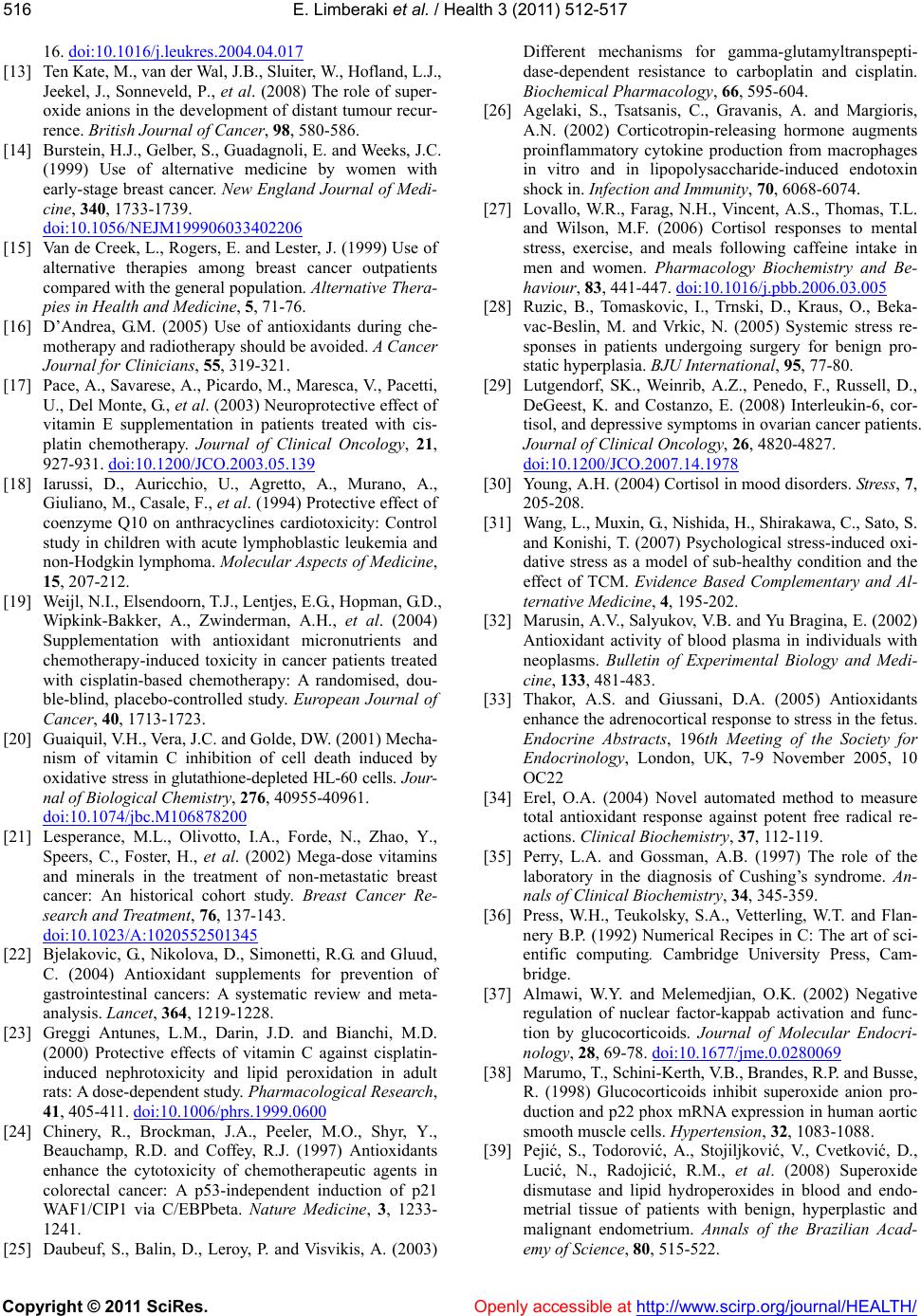
E. Limberaki et al. / Health 3 (2011) 512- 517
Copyright © 2011 SciRes. Openly accessible at http://www.scirp.org/journal/HEALTH/
516
16. doi:10.1016/j.leukres.2004.04.017
[13] Ten Kate, M., van der Wal, J.B., Sluiter, W., Hofland, L.J.,
Jeekel, J., Sonneveld, P., et al. (2008) The role of super-
oxide anions in the development of distant tumour recur-
rence. British Journal of Cancer, 98, 580-586.
[14] Burstein, H.J., Gelber, S., Guadagnoli, E. and Weeks, J.C.
(1999) Use of alternative medicine by women with
early-stage breast cancer. New England Journal of Medi-
cine, 340, 1733-1739.
doi:10.1056/NEJM199906033402206
[15] Van de Creek, L., Rogers, E. and Lester, J. (1999) Use of
alternative therapies among breast cancer outpatients
compared with the general population. Alternative Thera-
pies in Health and Medicine, 5, 71-76.
[16] D’Andrea, G.M. (2005) Use of antioxidants during che-
motherapy and radiotherapy should be avoided. A Cancer
Journal for Clinicians, 55, 319-321.
[17] Pace, A., Savarese, A., Picardo, M., Maresca, V., Pacetti,
U., Del Monte, G., et al. (2003) Neuroprotective effect of
vitamin E supplementation in patients treated with cis-
platin chemotherapy. Journal of Clinical Oncology, 21,
927-931. doi:10.1200/JCO.2003.05.139
[18] Iarussi, D., Auricchio, U., Agretto, A., Murano, A.,
Giuliano, M., Casale, F., et al. (1994) Protective effect of
coenzyme Q10 on anthracyclines cardiotoxicity: Control
study in children with acute lymphoblastic leukemia and
non-Hodgkin lymphoma. Molecular Aspects of Medicine,
15, 207-212.
[19] Weijl, N.I., Elsendoorn, T.J., Lentjes, E.G., Hopman, G.D.,
Wipkink-Bakker, A., Zwinderman, A.H., et al. (2004)
Supplementation with antioxidant micronutrients and
chemotherapy-induced toxicity in cancer patients treated
with cisplatin-based chemotherapy: A randomised, dou-
ble-blind, placebo-controlled study. European Journal of
Cancer, 40, 1713-1723.
[20] Guaiquil, V.H., Vera, J.C. and Golde, DW. (2001) Mecha-
nism of vitamin C inhibition of cell death induced by
oxidative stress in glutathione-depleted HL-60 cells. Jour-
nal of Biological Chemistry, 276, 40955-40961.
doi:10.1074/jbc.M106878200
[21] Lesperance, M.L., Olivotto, I.A., Forde, N., Zhao, Y.,
Speers, C., Foster, H., et al. (2002) Mega-dose vitamins
and minerals in the treatment of non-metastatic breast
cancer: An historical cohort study. Breast Cancer Re-
search and Treatment, 76, 137-143.
doi:10.1023/A:1020552501345
[22] Bjelakovic, G., Nikolova, D., Simonetti, R.G. and Gluud,
C. (2004) Antioxidant supplements for prevention of
gastrointestinal cancers: A systematic review and meta-
analysis. Lancet , 364, 1219-1228.
[23] Greggi Antunes, L.M., Darin, J.D. and Bianchi, M.D.
(2000) Protective effects of vitamin C against cisplatin-
induced nephrotoxicity and lipid peroxidation in adult
rats: A dose-dependent study. Pharmacological Research,
41, 405-411. doi:10.1006/phrs.1999.0600
[24] Chinery, R., Brockman, J.A., Peeler, M.O., Shyr, Y.,
Beauchamp, R.D. and Coffey, R.J. (1997) Antioxidants
enhance the cytotoxicity of chemotherapeutic agents in
colorectal cancer: A p53-independent induction of p21
WAF1/CIP1 via C/EBPbeta. Nature Medicine, 3, 1233-
1241.
[25] Daubeuf, S., Balin, D., Leroy, P. and Visvikis, A. (2003)
Different mechanisms for gamma-glutamyltranspepti-
dase-dependent resistance to carboplatin and cisplatin.
Biochemical Pharmacology, 66, 595-604.
[26] Agelaki, S., Tsatsanis, C., Gravanis, A. and Margioris,
A.N. (2002) Corticotropin-releasing hormone augments
proinflammatory cytokine production from macrophages
in vitro and in lipopolysaccharide-induced endotoxin
shock in. Infection and Immunity, 70, 6068-6074.
[27] Lovallo, W.R., Farag, N.H., Vincent, A.S., Thomas, T.L.
and Wilson, M.F. (2006) Cortisol responses to mental
stress, exercise, and meals following caffeine intake in
men and women. Pharmacology Biochemistry and Be-
haviour, 83, 441-447. doi:10.1016/j.pbb.2006.03.005
[28] Ruzic, B., Tomaskovic, I., Trnski, D., Kraus, O., Beka-
vac-Beslin, M. and Vrkic, N. (2005) Systemic stress re-
sponses in patients undergoing surgery for benign pro-
static hyperplasia. BJU International, 95, 77-80.
[29] Lutgendorf, SK., Weinrib, A.Z., Penedo, F., Russell, D.,
DeGeest, K. and Costanzo, E. (2008) Interleukin-6, cor-
tisol, and depressive symptoms in ovarian cancer patients.
Journal of Clinical Oncology, 26, 4820-4827.
doi:10.1200/JCO.2007.14.1978
[30] Young, A.H. (2004) Cortisol in mood disorders. St ress, 7,
205-208.
[31] Wang, L., Muxin, G., Nishida, H., Shirakawa, C., Sato, S.
and Konishi, T. (2007) Psychological stress-induced oxi-
dative stress as a model of sub-healthy condition and the
effect of TCM. Evidence Based Complementary and Al-
ternative Medicine, 4, 195-202.
[32] Marusin, A.V., Salyukov, V.B. and Yu Bragina, E. (2002)
Antioxidant activity of blood plasma in individuals with
neoplasms. Bulletin of Experimental Biology and Medi-
cine, 133, 481-483.
[33] Thakor, A.S. and Giussani, D.A. (2005) Antioxidants
enhance the adrenocortical response to stress in the fetus.
Endocrine Abstracts, 196th Meeting of the Society for
Endocrinology, London, UK, 7-9 November 2005, 10
OC22
[34] Erel, O.A. (2004) Novel automated method to measure
total antioxidant response against potent free radical re-
actions. Clinical Biochemistry, 37, 112-119.
[35] Perry, L.A. and Gossman, A.B. (1997) The role of the
laboratory in the diagnosis of Cushing’s syndrome. An-
nals of Clinical Biochemistry, 34, 345-359.
[36] Press, W.H., Teukolsky, S.A., Vetterling, W.T. and Flan-
nery B.P. (1992) Numerical Recipes in C: The art of sci-
entific computing. Cambridge University Press, Cam-
bridge.
[37] Almawi, W.Y. and Melemedjian, O.K. (2002) Negative
regulation of nuclear factor-kappab activation and func-
tion by glucocorticoids. Journal of Molecular Endocri-
nology, 28, 69-78. doi:10.1677/jme.0.0280069
[38] Marumo, T., Schini-Kerth, V.B., Brandes, R.P. and Busse,
R. (1998) Glucocorticoids inhibit superoxide anion pro-
duction and p22 phox mRNA expression in human aortic
smooth muscle cells. Hypertension, 32, 1083-1088.
[39] Pejić, S., Todorović, A., Stojiljković, V., Cvetković, D.,
Lucić, N., Radojicić, R.M., et al. (2008) Superoxide
dismutase and lipid hydroperoxides in blood and endo-
metrial tissue of patients with benign, hyperplastic and
malignant endometrium. Annals of the Brazilian Acad-
emy of Science, 80, 515-522.